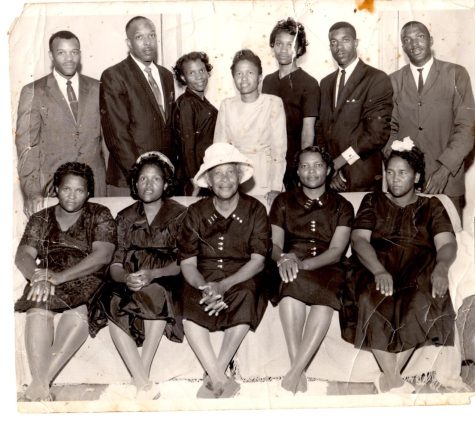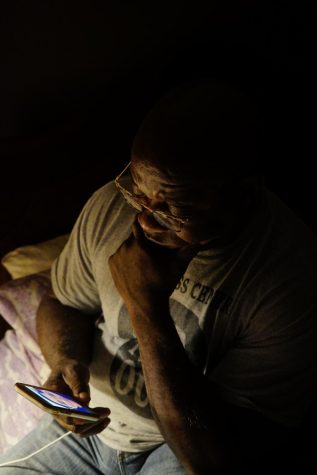Photo Courtesy of Rachel Coleman
Autry Coleman has lived through two historical times in the US- segregation and integration. Coleman shares his experiences and thoughts with Seward County Community College students.
Impacts of segregation to integration
Autry Coleman describes this transition period in his life
Even though breaking down the barriers of segregation was a step forward for the United States against racism, those who lived through it—like Autry Coleman—say the entire approach was wrong.
Coleman, the corrosion technology instructor at Seward County Community College, openly shares with students about his time growing up in a segregated nation, what the transition into integrated schools felt like and how his life developed after. He wants them to learn from the past.
Early Childhood:
Coleman describes the neighborhoods he lived in from, “bad to worse to awful.” They were “villagy” and had many social norms such as no one was allowed to walk on the pastor’s grass.
One of the stories he had was from the first neighborhood he remembered living in when he was 3 years old. His neighbor across the street was a Native American he called “Mr. Eddie” and behind them was a white family named the McCoys who were from Kentucky.
McCoy actually sold bootleg beer that he made from his own stills and the rest of the neighborhood would buy from him. Coleman said his favorite part was about “Mr. Eddie.”
“My favorite thing I remember was my Mom would try to rush us in the house by six and we would figure out why later. He would be outside in boxer shorts and cowboy boots with a cowboy hat late and he would yell at Mrs. Eddie real loud so everyone would hear saying, ‘Hey babydoll what you doin.’

She would yell back what she was doing something like cooking his dinner. He would respond with ah ‘shut up woman’ real loud and all of us kids would just die laughing. He would see us when we weren’t supposed to be out – we had snuck out. Every Friday night, he would yell and look over at us to see if we were laughing.”
The first school he went to was when he was four and all elementary schools he would attend after would be all-black schools.
In elementary school he met his mentor named A.J. Jones who was a physical education coach. Coleman credits the man he is today to Jones. Something Jones said to Coleman has stuck with him still today.
“‘Anything you want to you can put your mind to it and you can do anything you want to, young man. I see that in you.’ That resonated with me. I will never forget that. When I struggle, I remember that,” Coleman said.
The first six years of school were really good for him. He said going to all-black schools really helped seeing people with the same skin color as him in leadership positions. When junior high started for him, he went to his first integrated school in 1968-1969.
Integration:
Coleman said one of the biggest differences between all-black schools and integrated schools was the expectations that were put on the students. At his all-black school, students had to carry a B average and if someone couldn’t understand the lesson they would stay after school or get a tutor.
“I will never forget this one time. My basketball coach worked with me a lot to get me on the team. I had all As except for one B+. One time, I had gotten sick for three days but my Mother forgot to call the school. When I came back, my coach didn’t ask me anything just bent me over and WHA! WHA! WHA! Three whippings and gave me detention,” Coleman described the story while laughing in between.
He went on to explain that his grade had dropped the three days he was gone but after Coleman explained what had happened through his tears and the whole situation was figured out. His coach even took him out for ice cream after.
The school where the story happened was the last junior high school he went to. His basketball coach’s name was Coach Droke.
Coleman still remembers something Droke said to him.
“You can do great things because you have a rambunctious spirit,” Coleman quoted laughing as he didn’t even know what that word meant at the time. He credits Droke and Jones as the people who cultivated the person he is today.
When he went to an integrated school, the teachers didn’t care. In one of his first interactions with a white teacher, he said she didn’t care if he was there or not. Coleman had turned in his work and she didn’t even look at it before immediately grading it as an F.
When he confronted her about it, the teacher just waved him off saying he probably didn’t even try to work on it. Coleman got really mad and every day that he had homework, he would go to the library and work on it.
By the end of the year, he had gotten an A in her class and she cried. He had five Fs and one A. “I knew you had potential,” the teacher, Ms. Jackson, said after. “I knew you could do better than that because you have an intelligent way of doing things.”
Coleman didn’t like going to integrated schools and it was difficult — he didn’t feel like he was welcome or wanted. He spoke about how that feeling was shared amongst most young black people in an all-white school. Schools where people got to do what they wanted to, based on their skin color.
It was very hard for him and other people from segregated schools, who now had to walk into a classroom where they didn’t feel welcome. Coming from a place that felt like a family, it was a big difference.
“It was wrong. They should not have done that [integration]. I lived in the worst neighborhood ever in Oklahoma City. They had gangs and they would set up booths and rob them. Then they would turn over buses and kids were bleeding,” said Coleman.
Coleman explained seeing blood coming from someone at that age is scary.

“It doesn’t matter what color you are when your life is threatened like that and things are done to you in that manner,” he said. “When you’re on the receiving end it hurts you, but seeing it being done to someone else hurts just the same if you have any compassion.”
That sight shook him up – his mother talked him through it. That changed Coleman on what kind of person he was going to be and race.
Another reason why Coleman said they shouldn’t have integrated schools was because of the way they did it. Students had no voice in it or say in it while the leaders of the country did this massive move.
Coleman said he remembers even the secretary of education from Reagan’s administration saying that was the biggest mistake they ever made because of the way they did it. He believes they should’ve taken their time and picked certain places, waited a couple of years while watching what happened.
Coming to SCCC:
As Coleman grew older, he moved around quite a bit coming to Liberal then leaving again. The reason why Coleman actually ended up going to college at SCCC was because the coach called him up asking if he would come to play.
When he was a student here at Seward, there were only two black instructors at the time. The atmosphere he described as, “very ’70s, that will explain a lot.” For the most part, it was subtle racism because students didn’t know how to deal with it.

“Somebody had to tell you with authority not to be racist. It’s sad,” Coleman said.
After Coleman tore his Achilles tendon, the next year he came back with a new vision instead of pursuing basketball. He went into electronics getting his First Class License as an electronic technician.
Coleman met his wife here at Seward as well when she moved next door to him. He actually was planning on moving to Arizona for a job in coding but she talked him into staying. “And the rest is history.”
Compared to his years as a student, Coleman said he has seen changes in leaders and instructors. Instructors that will take the challenge of crossing racial and cultural barriers to grow themselves, in turn, helping the student feel accepted and comfortable.
“There is something about seeing someone else comfortable that helps you become comfortable,” said Coleman.
As SCCC moves forward into the future, a change he would like to see is in some of the processes here. Currently in place are some processes that to him limit the instructors and students from their potential. The change to him can start here, now, in Seward.
Coleman describes Liberal to have a variety of cultures and ethnic groups. Even though he’s been too big cities like Chicago and New York, he says someone will never find this on such a small scale with this many different cultures anywhere else.
“If we are going to break those barriers and begin to show a great example of what success can be, this [Liberal] is probably going to be the best chance for this country. Big cities don’t have that small-town mentality.
If there is ever going to be a chance for the country to understand the idea of how to live beyond the cultural boundaries, come out here and look and see.”
Coleman truly believes that in Southwest Kansas change can be made.

